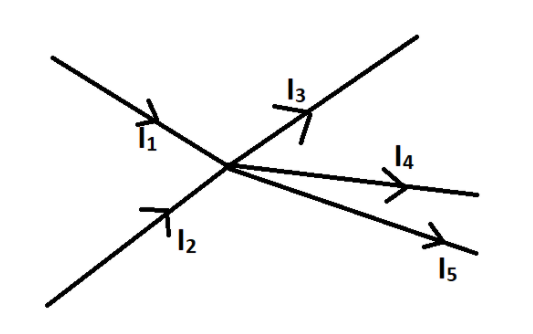
Kirchoff's law of of junctions is also called the law of conservation of:
(A) Energy
(B) Charge
(C) Momentum
(D) Angular Momentum
Answer
218.4k+ views
Hint Kirchoff's law of junctions tells us about the distribution of current in a circuit. It states that at a junction of a circuit (which is a place where several wires are joined), total ingoing current on that junction from one side should be equal to total outgoing current to the other side.
Complete step by step answer:
Current in a circuit is due to flow of charge along the wire in the circuit. Since, Kirchoff’s law states that total current coming from one side in the junction is equal to total outgoing current to other sides of the junction.
Since, rate of flow of charge is current, therefore, total charge coming to the junction should be equal to the outgoing charge from the junction.

In the above figure, since ${I_1}$, ${I_2}$ are incoming current and ${I_3}$, ${I_4}$, ${I_5}$ are outgoing current, therefore according to Kirchoff's law of junction,
${I_1} + {I_2} = {I_3} + {I_4} + {I_5}$ ---------(1)
Now, we know that, $I = \dfrac{{dq}}{{dt}}$,
So, ${I_1} = \dfrac{{d{q_1}}}{{dt}}$, ${I_2} = \dfrac{{d{q_2}}}{{dt}}$, ${I_3} = \dfrac{{d{q_3}}}{{dt}}$, ${I_4} = \dfrac{{d{q_4}}}{{dt}}$ and ${I_5} = \dfrac{{d{q_5}}}{{dt}}$,
Using above in equation $1$,
$\dfrac{{d{q_1}}}{{dt}} + \dfrac{{d{q_2}}}{{dt}} = \dfrac{{d{q_3}}}{{dt}} + \dfrac{{d{q_4}}}{{dt}} + \dfrac{{d{q_5}}}{{dt}}$
On simplifying we get,
$d{q_1} + d{q_2} = d{q_3} + d{q_4} + d{q_5}$ -------(2)
Now, we know that $\int_0^x {dx} = x$,
So on integrating equation $2$, we get,
$\int_0^{{q_1}} {d{q_1}} + \int_0^{{q_2}} {d{q_2}} = \int_0^{{q_3}} {d{q_3}} + \int_0^{{q_4}} {d{q_4}} + \int_0^{{q_5}} {d{q_5}} $
So, on simplifying we get,
${q_1} + {q_2} = {q_3} + {q_4} + {q_5}$,
This proves that the Kirchoff's law of junction tells about the conservation of charge.
So correct option in Option (B).
Note In equation $2$, we do not have integral constant, because the integration was definite. This law of Kirchoff is very useful in solving circuits as it gives us the equation for finding current. The number of equations by this law will be equal to the number of junctions in the circuit.
Complete step by step answer:
Current in a circuit is due to flow of charge along the wire in the circuit. Since, Kirchoff’s law states that total current coming from one side in the junction is equal to total outgoing current to other sides of the junction.
Since, rate of flow of charge is current, therefore, total charge coming to the junction should be equal to the outgoing charge from the junction.

In the above figure, since ${I_1}$, ${I_2}$ are incoming current and ${I_3}$, ${I_4}$, ${I_5}$ are outgoing current, therefore according to Kirchoff's law of junction,
${I_1} + {I_2} = {I_3} + {I_4} + {I_5}$ ---------(1)
Now, we know that, $I = \dfrac{{dq}}{{dt}}$,
So, ${I_1} = \dfrac{{d{q_1}}}{{dt}}$, ${I_2} = \dfrac{{d{q_2}}}{{dt}}$, ${I_3} = \dfrac{{d{q_3}}}{{dt}}$, ${I_4} = \dfrac{{d{q_4}}}{{dt}}$ and ${I_5} = \dfrac{{d{q_5}}}{{dt}}$,
Using above in equation $1$,
$\dfrac{{d{q_1}}}{{dt}} + \dfrac{{d{q_2}}}{{dt}} = \dfrac{{d{q_3}}}{{dt}} + \dfrac{{d{q_4}}}{{dt}} + \dfrac{{d{q_5}}}{{dt}}$
On simplifying we get,
$d{q_1} + d{q_2} = d{q_3} + d{q_4} + d{q_5}$ -------(2)
Now, we know that $\int_0^x {dx} = x$,
So on integrating equation $2$, we get,
$\int_0^{{q_1}} {d{q_1}} + \int_0^{{q_2}} {d{q_2}} = \int_0^{{q_3}} {d{q_3}} + \int_0^{{q_4}} {d{q_4}} + \int_0^{{q_5}} {d{q_5}} $
So, on simplifying we get,
${q_1} + {q_2} = {q_3} + {q_4} + {q_5}$,
This proves that the Kirchoff's law of junction tells about the conservation of charge.
So correct option in Option (B).
Note In equation $2$, we do not have integral constant, because the integration was definite. This law of Kirchoff is very useful in solving circuits as it gives us the equation for finding current. The number of equations by this law will be equal to the number of junctions in the circuit.
Recently Updated Pages
Arithmetic, Geometric & Harmonic Progressions Explained

Cartesian Form of Vector Explained: Formula, Examples & Uses

Apparent Frequency Explained: Formula, Uses & Examples

Calorimetry: Definition, Principles & Calculations

Centrifugal Force Explained: Definition, Formula & Examples

Charge in a Magnetic Field: Definition, Formula & Examples

Trending doubts
JEE Main 2026: Application Form Open, Exam Dates, Syllabus, Eligibility & Question Papers

Derivation of Equation of Trajectory Explained for Students

Hybridisation in Chemistry – Concept, Types & Applications

Understanding the Angle of Deviation in a Prism

Understanding Collisions: Types and Examples for Students

Understanding Atomic Structure for Beginners

Other Pages
JEE Advanced Marks vs Ranks 2025: Understanding Category-wise Qualifying Marks and Previous Year Cut-offs

How to Convert a Galvanometer into an Ammeter or Voltmeter

Ideal and Non-Ideal Solutions Explained for Class 12 Chemistry

Degree of Dissociation: Meaning, Formula, Calculation & Uses

Understanding Electromagnetic Waves and Their Importance

Understanding Average and RMS Value in Electrical Circuits




